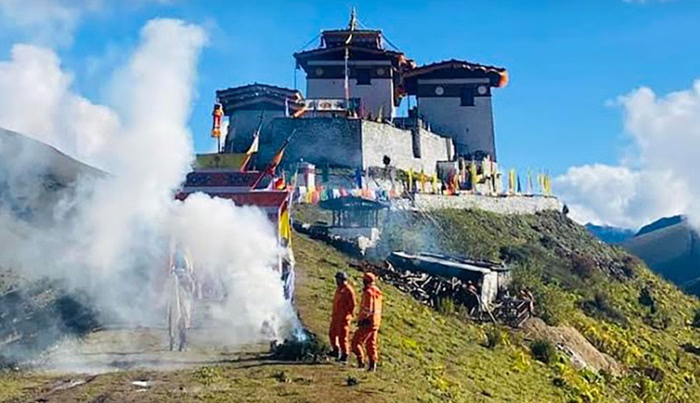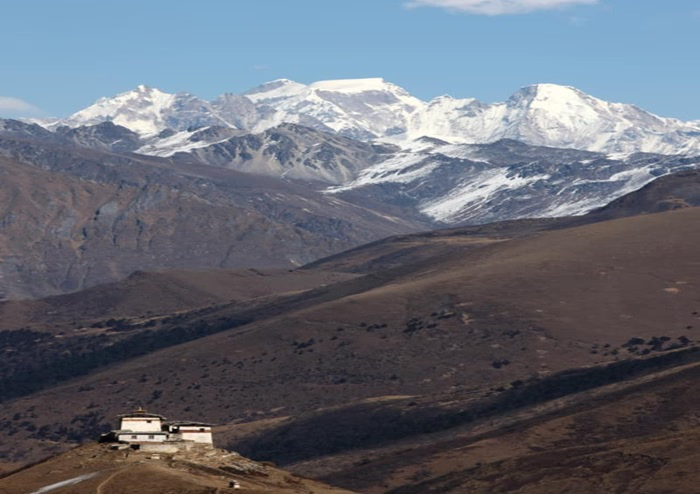Lingzhi Dzong, also known as Lingzhi Fortress, is a remarkable historical and cultural site located in the Bhutanese district of Thimphu. Nestled at an elevation of approximately 4,000 meters (13,123 feet) in the northwestern region of Bhutan, this dzong is not only an architectural marvel but also a significant symbol of Bhutanese spirituality and culture.
Historical Background of Lingzhi Dzong
Originally built between 1667 and 1680 during the reign of the third Druk Desi, Chogyal Minjur Tenpa, Lingzhi Yugyal Dzong commemorates Bhutan’s victory over Tibetan invasions, earning its name, Yugyal Dzong. It was first destroyed by an earthquake in 1897, rebuilt in the 1950s, and partially renovated in 2005.
It is strategically located on a ridge that overlooks the valley, providing a defensive advantage while also showcasing the stunning natural beauty of the surrounding landscape. For centuries, the Dzong has served as both an administrative and religious center, symbolizing Bhutanese resilience against external threats while showcasing the country’s unique architectural heritage. Positioned on the northern frontier, the Dzong has played a critical role in defending Bhutan’s borders and ensuring regional security, representing peace, stability, and sovereignty.
The dzong has undergone various renovations and restorations over the centuries, particularly after suffering from damage due to natural elements. Despite these challenges, Lingzhi Dzong has retained much of its original charm and remains a vital part of Bhutan's cultural heritage.

Photo credit: Kuensel Online
Reconstruction and Consecration
Lingzhi Dzong was consecrated on 5th October 2024 by the Dorji Lopen of Zhung Dratshang upon completion of the reconstruction, which took nearly seven years.
The reconstruction project, funded by the Government of India in the 12th Plan with a budget of Nu 400 million, began in 2018. However, only about Nu 180 million has been spent so far. The project was led by the Department of Culture and Dzongkha Development and executed by the Thimphu Dzongkhag Administration.
One of the most remarkable aspects of the project is that all the workers involved were open-air prisoners (OAPs). Over 100 individuals worked at an altitude of 4,150 meters for nearly seven years to reconstruct the Dzong.

Photo credit: Kuensel Online
Architectural Features of Lingzhi Dzong
Lingzhi Dzong is a quintessential example of traditional Bhutanese architecture, characterized by its impressive stonework, intricate wood carvings, and vibrant murals. The dzong's layout includes a series of courtyards, prayer halls, and monastic quarters, all enclosed within massive walls.
The exterior of the dzong features high walls made from locally sourced stone and is adorned with traditional Bhutanese motifs, reflecting the deep-rooted Buddhist beliefs of the region. The interior is equally captivating, with numerous statues of Buddhist deities, intricate thangka paintings, and beautifully crafted woodwork that narrate various aspects of Bhutanese mythology and spirituality.
Cultural Significance
Lingzhi Dzong serves as a vital center for Buddhism in the region. It houses a community of monks who engage in various religious practices, including rituals, prayers, and meditation. The dzong is also a site for important religious festivals, where locals gather to celebrate Bhutanese culture and traditions. The most notable festival is the annual Tsechu, which features traditional dances, music, and vibrant costumes, drawing visitors from across the country and beyond.
The dzong is not only a religious center but also a symbol of Bhutan's independence and resilience. It stands as a reminder of the country's efforts to preserve its cultural identity and heritage in the face of modernization and globalization.
What’s inside Lingzhi Dzong?
Among the main relics housed within the Dzong are the Zhabdrung’s chag roel (cymbal) and a silver-carved, gold-plated saddle used by Zhabdrung when he arrived in Bhutan on horseback. Other significant Ku Ten Sung Ten include statues of Shakya Thupa, Chenrezig, Phajo Drugom Zhigpo, Guru Pema Jungney, and Gonpo Tsepagme, along with the revered Bum Sey Dem (gold script).
A new Heritage Gallery was also established in Lingzhi Dzong. The exhibition showcases the history, culture, and traditions of Bhutan and displays artifacts that highlight significant historical events, achievements, and cultural heritage, aiming to preserve and educate visitors about the past.
Druk Asia supported the establishment of the Heritage Gallery as part of their commitment to promote and preserve Bhutan's unique culture.
Where is Lingzhi Dzong?
Lingzhi Dzong, also known as Lingzhi Yugyal Dzong, is located in the Lingzhi region of Thimphu District, in northern Bhutan. It sits at an elevation of approximately 4,150 meters (13,615 feet) and is situated near the Tibetan border, serving as an important fortress along Bhutan’s northern frontier. The Dzong is renowned for its strategic location and historical significance, playing a key role in Bhutan's defense and cultural heritage. There are about thirty monks headed by a Lama Neten (head of a district monastic body) resident in the Dzong.
Lingzhi Dzong is perched atop a steep hillock in a narrow valley, surrounded by the villages of Zombuthang and Misayue. This strategic location not only gave the Dzong its defensive advantage but also offers panoramic views of the surrounding Himalayan landscape. To the northwest of the Dzong, the imposing twin peaks of Jichu Drake and Tserim Gung rise majestically, adding to the dramatic scenery.

Photo credit: Department of Tourism
How to visit Lingzhi Dzong?
Due to its remote location in the high-altitude northern region of Thimphu District, reaching Lingzhi Dzong typically requires a multi-day trek, providing a challenging yet rewarding experience for trekkers who venture through Bhutan's rugged landscapes. The trek to Lingzhi Dzong takes approximately four days from Paro, with popular routes including the Laya-Gasa Trek (21 days), Jomolhari Trek (11 days) or the challenging Snowman Trek (28 days), each providing breathtaking scenery and a rewarding challenge. It offers a rare opportunity to witness the rugged beauty of the Bhutanese Himalayas while exploring a vital piece of Bhutan’s history.
For those who prefer a more comfortable journey, luxurious helicopter services are also available through Bhutan Helicopter Services, offering a swift and scenic alternative to reach this stunning Dzong.
Lingzhi Dzong stands as a testament to Bhutan's rich cultural heritage and spiritual depth. Its historical significance, architectural beauty, and serene environment make it a must-visit destination for anyone traveling to Bhutan. As a place where history, spirituality, and natural beauty converge, Lingzhi Dzong continues to inspire and captivate all who visit, inviting them to explore the profound traditions of this enchanting Himalayan kingdom.
